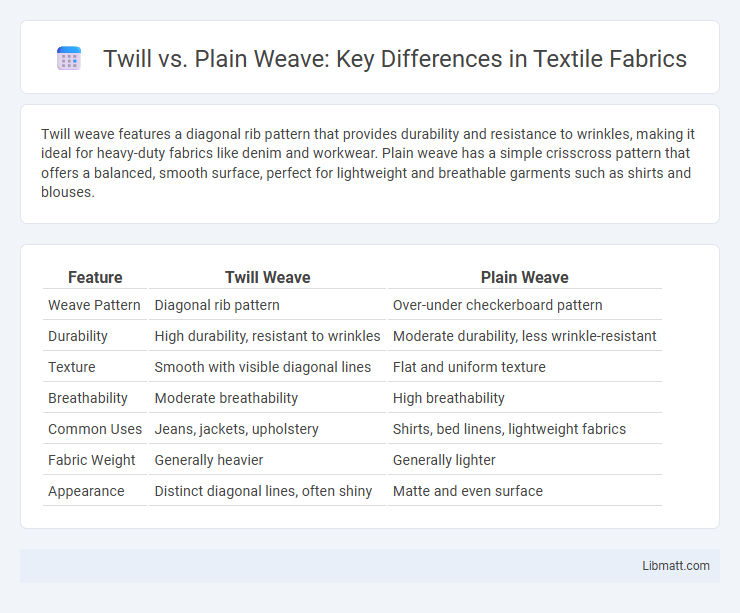Twill weave features a diagonal rib pattern that provides durability and resistance to wrinkles, making it ideal for heavy-duty fabrics like denim and workwear. Plain weave has a simple crisscross pattern that offers a balanced, smooth surface, perfect for lightweight and breathable garments such as shirts and blouses.
Table of Comparison
| Feature | Twill Weave | Plain Weave |
|---|---|---|
| Weave Pattern | Diagonal rib pattern | Over-under checkerboard pattern |
| Durability | High durability, resistant to wrinkles | Moderate durability, less wrinkle-resistant |
| Texture | Smooth with visible diagonal lines | Flat and uniform texture |
| Breathability | Moderate breathability | High breathability |
| Common Uses | Jeans, jackets, upholstery | Shirts, bed linens, lightweight fabrics |
| Fabric Weight | Generally heavier | Generally lighter |
| Appearance | Distinct diagonal lines, often shiny | Matte and even surface |
Introduction to Fabric Weaves
Twill and plain weave are fundamental fabric weaves characterized by their unique interlacing patterns that define texture and durability. Twill weave features a diagonal rib pattern created by weaving weft threads over multiple warp threads, providing superior strength and drape suited for denim and upholstery. Plain weave involves a simple crisscross pattern where each weft thread passes over one warp thread, resulting in a balanced, firm fabric ideal for shirts and lightweight materials.
What is Plain Weave?
Plain weave is the most basic and widely used textile weave pattern, characterized by its simple over-and-under structure. Each weft thread crosses the warp threads one at a time, producing a strong, durable fabric with a uniform surface. This weave is ideal for creating lightweight, breathable materials suitable for everyday clothing and home textiles.
Key Features of Plain Weave
Plain weave features a simple over-under pattern where each weft thread crosses over one warp thread and then under the next, creating a balanced, durable fabric structure. The tight interlacing results in a smooth surface with minimal stretch, making it ideal for fabrics like cotton shirting and canvas. This weave's high stability and resistance to snagging provide excellent support for printed or embroidered designs.
Understanding Twill Weave
Twill weave features a distinctive diagonal rib pattern created by passing the weft thread over one or more warp threads and then under two or more warp threads, providing durability and a soft texture. This structure offers excellent drape and resistance to wrinkles, making it ideal for sturdy fabrics like denim, chino, and upholstery. Understanding twill weave helps you choose materials that combine strength with flexibility for a variety of uses.
Distinct Characteristics of Twill Weave
Twill weave is characterized by its distinctive diagonal rib pattern created through a three-over, one-under weaving sequence, which gives the fabric enhanced durability and resistance to wrinkles compared to plain weave. This structure allows for a softer texture and better drape, making twill fabrics ideal for items like jeans and jackets that require strength and flexibility. Your choice of twill weave ensures longevity and a visually appealing texture distinct from the flat, grid-like appearance of plain weave fabrics.
Visual Differences: Twill vs Plain Weave
Twill weave features a distinctive diagonal rib pattern created by the weft thread passing over multiple warp threads in a staggered sequence, giving fabric a textured, durable appearance. Plain weave displays a simple, crisscross pattern where each weft thread alternates over and under one warp thread, resulting in a flat, uniform surface with balanced strength. The visual contrast between twill's angled lines and plain weave's checkerboard-like grid directly influences fabric selection for denim, shirting, and upholstery.
Durability and Strength Comparison
Twill weave exhibits superior durability and strength compared to plain weave due to its diagonal rib pattern, which distributes stress more evenly across the fabric. The interlacing structure in twill creates a denser, thicker textile that resists tearing and abrasion better than the plain weave's simple over-under pattern. Fabrics like denim and gabardine, which utilize twill weave, are renowned for their robustness in heavy-duty applications, whereas plain weave is typically found in lightweight, less durable fabrics such as muslin and poplin.
Applications and Uses in Textiles
Twill weave's diagonal pattern creates a durable, flexible fabric ideal for denim, workwear, and upholstery, offering superior strength and wrinkle resistance compared to plain weave. Plain weave, with its simple over-under structure, is widely used in lightweight garments, shirting, and home textiles, providing breathability and a smooth surface for printing. Your choice between twill and plain weave depends on the required fabric durability, aesthetic, and texture for specific textile applications.
Pros and Cons: Twill vs Plain Weave
Twill weave offers increased durability and better wrinkle resistance compared to plain weave, making it ideal for garments like jeans and workwear. Plain weave provides a simple, tight structure that results in a lightweight and breathable fabric, but it is less resistant to wear and tear than twill. While twill's diagonal rib pattern enhances texture and drape, plain weave's balanced crisscross pattern ensures maximum stability and ease of printing, with trade-offs in strength and texture quality.
Choosing the Right Weave for Your Needs
Twill weave features diagonal rib patterns that provide durability and drape, making it ideal for heavy-duty fabrics like denim and workwear, while plain weave offers a simple, tight crisscross that ensures strength and breathability for lightweight garments such as shirts and bed linens. When choosing the right weave for your needs, consider factors like fabric texture, durability, and appearance to suit both function and style. Your selection will impact fabric performance, comfort, and overall garment longevity.
Twill vs Plain Weave Infographic

 libmatt.com
libmatt.com